18 April 2005

Civil Disturbance Operations in Confinement Facilities
z
What is the condition of the area where the inmate is currently
located?
z
Has the inmate tested positive for human immunodeficiency virus
(HIV)?
z
Does the inmate have a weapon or the materials needed to make one?
z
Is the area barricaded?
z
Has he smeared himself with body fluids or other slippery substances?
z
Can you approach the inmate without risk to him and/or others?
7-61. The team is assembled for inspection by the OIC, and the team
members are required to brief the OIC on their individual duties and
responsibilities. A line formation is the customary formation for this
inspection. It should take place out of site of the inmates.
7-62. Each soldier takes one step forward and briefs the OIC as shown in the
following example: “I am (rank and name), team member one. My mission is to pin the inmate using the minimum amount of force necessary. I carry the
pinning shield.” He then faces so the camera can record the number printed on the back of his flak jacket and holds up the pinning shield [see Figure 7-2]).
Figure 7-2. Recording Team Members’ Duty Position
INDIVIDUAL TEAM MEMBER RESPONSIBILITIES
7-63. Each individual team member has his own responsibilities during a
forced cell move. Each team member must do his designated job while working
as a team.
Team Member One
7-64. Team member one is the eyes and ears of the team. His responsibility is to carry the pinning shield up to the cell door and describe the scene with as much detail as possible (especially including anything that may cause harm to
the team). The pinning shield is used to protect the team from body fluids
thrown at the them by the inmate.
7-65. Team member one describes the scene in the cell to his teammates by
turning his head to the right and speaking in a loud voice so that all team
members can hear him. A slap on the right shoulder by team member two
18 April 2005
FM 3-19.15
7-13
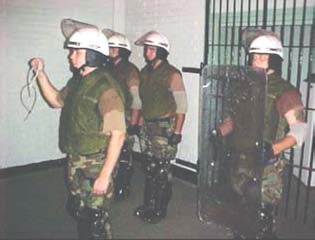
Civil Disturbance Operations in Confinement Facilities
alerts him that all team members have heard him. If he receives a slap on the
left shoulder from team member two, he repeats the situation report
(SITREP) in a loud, clear voice. The decision to enter the inmate’s area with or without the pinning shield is team member one’s decision, unless the inmate
is known to have a weapon. Should he decide to enter without the pinning
shield, team member one then enters with both hands held approximately
chest high. When team member one is unable to determine if the inmate has a
weapon, the pinning shield is used. Charging through the open cell door, team
member one drives the inmate to the bunk or ground with the shield. Once
pinned, team member one secures the inmate’s head and ensures that it is not
twisted or turned in relation to its natural form. He may have to use the
various pressure points on the inmate’s head to help subdue him.
Team Member Two
7-66. Team member two steps forward and briefs the OIC as follows: “I am
(rank and name), team member two. My mission is to secure the inmate’s right arm using the minimum amount of force necessary. I carry one set of hand
irons.” He then holds the hand irons up for video camera taping (see
Figure 7-3) and says, “I also carry one canister of OC pepper spray to be used at the direction of the team OIC.” He then holds up the canister for video camera taping and faces so the camera can record the number on the back of his flak
jacket (see Figure 7-2, page 7-13.)
Figure 7-3. Recording Team Members’ Equipment
7-67. Team member two lines up directly behind team member one. He keeps
contact with team member one until he can secure the inmate’s strong arm.
Team member two taps team member one on his right or left shoulder after
being tapped by team member three. Once inside the cell, team member two
secures the prisoners strong hand with wrist restraints and announces,
“Hands secure,” to team member five.
Team Member Three
7-68. Team member three steps forward and briefs the OIC as follows: “I am (rank and name), team member three. My mission is to secure the inmate’s left arm using the minimum amount of force necessary.” He then faces so the camera can record the number on the back of his flak jacket (see Figure 7-4).
7-14
FM 3-19.15
18 April 2005

Civil Disturbance Operations in Confinement Facilities
Team member three lines up directly behind team member two. Team
member three keeps contact with team member two until he can grasp a
portion of the inmate’s body. He then concentrates on securing the inmate’s
weak hand and assisting team member two in applying hand restraints. Team
member three taps team member two on his right or left shoulder after being
tapped by team member four.
Figure 7-4. Recording Number on Flak Jacket
Team Member Four
7-69. Team member four steps forward and briefs the OIC as follows: “I am
(rank and name), team member four. My mission is to secure the inmate’s right leg using the minimum amount of force necessary. I carry one set of leg irons.”
He holds the leg irons up for the camera to record (see Figure 7-2, page 7-13).
He then faces so the camera can record the number on the back of his flak
jacket (see Figure 7-2). Team member four lines up directly behind team member three. He taps team member three on his right or left shoulder after
being tapped by team member five. Team member four keeps contact with
team member three until he can secure a portion of the inmate’s body. Team
member four concentrates on securing the right leg of the inmate. It is his
responsibility to apply the leg irons. Once the legs are secure, he announces,
“Legs secure,” to team member five.
Team Member Five (Team Leader)
7-70. Team member five steps forward and briefs the OIC as follows: “I am (rank and name), team member five. My mission is to secure the inmate’s left leg using the minimum amount of force necessary. I carry a restraint key (hold up for the camera to view). I am also the team leader for this mission and it is my responsibility to ensure that the team uses the minimum amount of force necessary to subdue the inmate.” He then faces so the camera can record the number on the back of his flak jacket (see Figure 7-4).
7-71. Team member five taps team member four on the right shoulder when
he has heard the SITREP from team member one. If he does not hear the
report or needs to hear it again, he taps team member four on the left
shoulder. Team member five keeps in contact with team member four until he
can secure a portion of the inmate’s body. He secures the left leg and assists 18 April 2005
FM 3-19.15
7-15
Civil Disturbance Operations in Confinement Facilities
team member four in applying the leg irons. Once he has heard that the hands
and legs are secure, team member five signals for the team to conduct an
equipment check. The team members check the equipment in place.
NOTE: At no time is the inmate to be released by anyone.
Medic
7-72. The medic briefs the OIC in the following manner: “I am (rank and
name), the medic. My mission is to treat all injuries that may occur during the move.” He follows the instructions given to him by the OIC/NCOIC. His
mission is to observe the inmate for signs of injury before the forced cell move and assess the inmate’s condition during and after the move.
Military Police Investigator
7-73. The military police investigator (MPI) is responsible for videotaping the entire forced cell move. This includes the OIC/NCOIC briefing the OPORD,
each team member briefing his responsibilities to the OIC, and any medical
treatment rendered to the inmate.
ACTIONS DURING THE FORCED CELL MOVE
7-74. There are many actions performed during a forced cell move. Each
member of the FCMT must complete his task successfully to accomplish the
forced cell move.
Officer in Charge or Noncommissioned Officer in Charge
7-75. The OIC, an E7 or above, is responsible for ensuring that the team uses the minimum amount of force necessary to subdue the inmate. He is also
responsible for ensuring that all necessary precautions have been taken to
ensure the safety of the team and the inmate. The OIC gives the inmate the
initial orders to comply and informs him of the consequences of
noncompliance. He does this by placing himself at the front of the inmate’s cell (see Figure 7-5). The orders are not given until it can be enforced by the FCMT. The following prepared statement is read to the inmate by the OIC: “I am (rank and name), OIC of this FCMT. At this time I am ordering you to lie face down on your bunk (or other designated location) with your head to the rear of the cell. Cross your hands behind your back and cross your feet as the team enters the cell and uses the minimum amount of force necessary to place you in restraints and move you to (give location). Failure on your part to comply with these instructions or to resist the FCMT will result in the use of force (OC pepper spray if applicable). Do you understand these instructions? If so, lie down on the bunk.”
7-76. After reading the instructions to the inmate, the OIC faces the camera
and states whether the inmate complied. He then waits 60 seconds and
motions for the team to position itself in front of the inmate’s cell (see
Figure 7-6). The OIC directs the opening of the cell when the team is positioned at the entrance to the cell and prepared to enter. He positions
himself so he can observe team entry to and departure from the cell. If OC
7-16
FM 3-19.15
18 April 2005
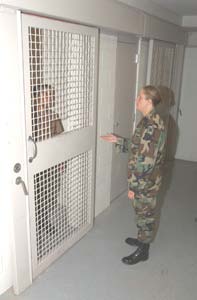
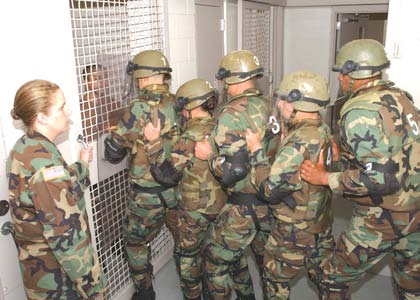
Civil Disturbance Operations in Confinement Facilities
spray is authorized, the OIC tells the team when to spray the inmate with OC
spray. This task is done in silence. Communication between team members
should be done through hand-and-arm signals, unless noted otherwise.
Figure 7-5. OIC Reading Compliance Statement to Inmate
Figure 7-6. OIC and FCMT
Team Member One
7-77. Once the team is positioned in front of the inmate’s cell, team member
one starts his report. At a minimum, he must answer the following questions
and report them to the team:
z
Does the inmate have a weapon, if so, what kind?
z
Does the inmate appear dry?
z
Is the inmate clothed or wearing extra clothing?
z
Has the inmate smeared anything on his body?
z
Can you see the inmate’s hands?
z
Is the cell barricaded or visibly booby-trapped?
18 April 2005
FM 3-19.15
7-17
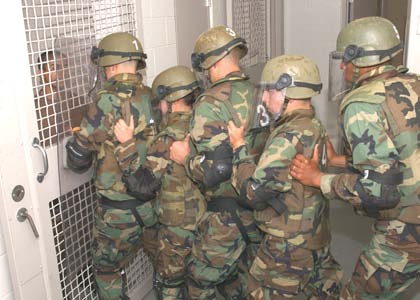
Civil Disturbance Operations in Confinement Facilities
z
Is the cell dry?
z
Are cell furnishings intact?
7-78. Based on the answers to the above questions, team member one must
decide whether to enter the cell with or without the shield (see Figure 7-7).
Team member one’s ultimate goal is to pin the inmate on the bunk or floor.
Figure 7-7. FCMT Preparing to Enter a Cell
Team Member Two
7-79. Team member two keeps contact with team member one until he can
secure the inmate’s strong arm. If he cannot immediately secure the inmate’s
arm, he secures a portion of the inmate’s body and progresses to the inmate’s
strong arm. Once the inmate’s hands are secure, he announces, “Hands
secure,” to team member five (see Figure 7-8).
Team Member Three
7-80. Team member three keeps contact with team member two until he can
grasp a portion of the inmate’s body. Team member three concentrates on
securing the inmate’s weak hand and assists team member two in applying
Flex-Cufs. Team member three maintains control of the inmate’s hands and
looks at team member five for further instructions (see Figure 7-8).
Team Member Four
7-81. Team member four keeps contact with team member three until he can
secure a portion of the inmate’s body. Team member four concentrates on
securing the inmate’s right leg. He applies leg irons and when the inmate’s
legs are secure, he announces, “Legs secure,” (see Figure 7-8).
Team Member Five (Team Leader)
7-82. Team member five keeps contact with team member four until he
secures a portion of the inmate’s body. Team member five concentrates on
securing the inmate’s left leg and assists with the application of leg irons.
When he is informed that the hands and legs are secure, the team searches
7-18
FM 3-19.15
18 April 2005
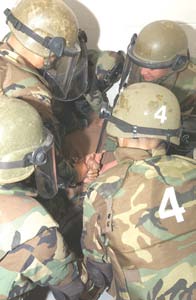
Civil Disturbance Operations in Confinement Facilities
the inmate for weapons and contraband. Once the search is complete, team
member five commands, “Prepare to Lift.”
Figure 7-8. FCMT Securing an Inmate
Movement of the Inmate
7-83. Team member one positions his hands to control the inmate’s head
during the move, turning the inmate’s head toward the wall. Team members
two and three position themselves on the inmate’s right and left sides. They
grasp the wrist or forearm of the team member opposite them to form a
platform for the inmate to lie on. Team member four positions himself on the
inmate’s right side even with the inmate’s knees. This places him in position
to control the inmate’s legs. Team member five’s position is on the inmate’s
left side and enables him to control the inmate’s lower legs and feet. When in position, team member five ensures that all team members are in place before
commanding, “Ready, Lift.”
7-84. On the command “Lift,” all team members simultaneously stand with
the inmate. They should sandwich the inmate between them to facilitate
control. Team member five then commands, “Prepare to Turn, Ready—Turn.”
The inmate is always turned toward the bunk. If a bunk is not available, team
member five should specify which direction to turn the inmate. The inmate is
then removed from the cell (see Figure 7-9, page 7-20).
7-85. Once the inmate is on the tier, team member five commands, “Prepare
to Lower, Team—Lower.” The team simultaneously lowers the inmate to the
floor with the team keeping positive control of the inmate. The medic asks the inmate, “Do you have any injuries at this time? ” (see Figure 7-10, page 7-20). If the inmate has no injuries, the medic looks at the camera and states, “Inmate (inmate name) appears to have sustained no injuries.” If the inmate has sustained injuries, the medic treats those injuries and completes a sworn
statement. If OC was employed, the medic decontaminates the inmate using
water and paper towels. The medic instructs the inmate to tilt his head to the side and flush his eyes with water for approximately 5 minutes. The medic
then dries the inmate’s face.
18 April 2005
FM 3-19.15
7-19
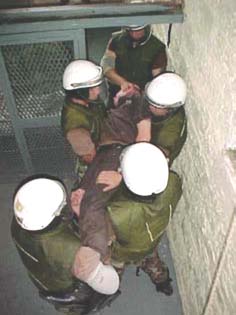
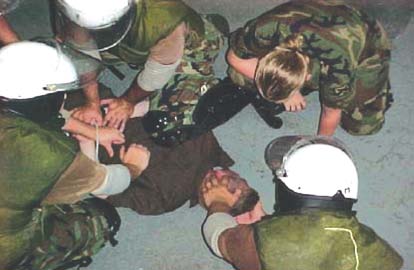
Civil Disturbance Operations in Confinement Facilities
Figure 7-9. Moving the Inmate
Figure 7-10. Treating Injuries
Placement of the Inmate in a Cell
7-86. Team member five orders an equipment check before returning the
inmate to a cell. He then commands, “Prepare to Lift, Team—Lift.” Team
members position themselves exactly where they were when they removed the
inmate from the cell. Next, team members simultaneously lift the inmate and
return him to the predetermined cell. They move the inmate into the cell head
first with his face toward the bunk. Once inside the cell, team member five
commands the team to lower the inmate onto the bunk (see Figure 7-11, page 7-20). Team members then remove the inmate’s restraints, keeping positive
control of the inmate at all times. Team members use a nonverbal signal to
notify team member five when the restraints are removed. He signals another
equipment check. Team members then account for all equipment in place and
prepare to exit the cell. The team exits the cell in the same manner as they
entered, but in reverse order.
7-20
FM 3-19.15
18 April 2005
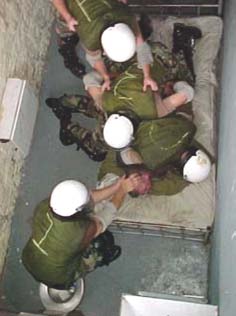
Civil Disturbance Operations in Confinement Facilities
Figure 7-11. Placing Inmate in Cell
7-87. Team member four moves into position where he can control both of the
inmate’s legs while team member five moves toward the cell door. When team
member four is ready to exit the cell, team member three moves to control the
inmate’s legs, team member two moves to where he can control both of the
inmates arms, and team member one maintains control of the inmate’s head.
Team member four maintains contact with team member three at all times.
When team member three is ready to exit the cell, team member two moves
into a position where he can control the inmate’s lower body and team
member one moves into position to control the inmate’s upper body. Using a
prearranged, nonverbal signal, the team pulls team members one and two
from the cell. The FCMT is prepared to reenter the cell if the inmate attempts to attack team members one and two as they exit the cell. The FCMT remains
ready to reenter until the cell door is secured.
18 April 2005
FM 3-19.15
7-21
This page intentionally left blank.
Chapter 8
Civil Disturbance Training
Training requires planning and preparation. Unit commanders structure
their training program according to the mission essential task list (METL)
(see FM 7-1) and expected contingencies. These training plans include
prior training and the experience and proficiency of their unit. Leaders
agree that the operational tempo and expected contingencies for the next
10 to 15 years will likely involve low-intensity military operations other
than war (MOOTW). Therefore, civil disturbance training must be
included in the commander’s annual training program and must cover all
aspects of that type of operation. To effectively function as a member of a
control force, individual soldiers must be trained in civil disturbance
operations. Training must be intensive, realistic, and sustained. Any lack
of training (from basic soldier skills to leadership skills) can have an
adverse effect to the point of endangering lives, especially the lives of
soldiers. Leader involvement in the training process is essential for
mission success in crowd control operations.
UNIT TRAINING STRATEGY DEVELOPMENT
8-1. Developing a unit training strategy begins with the mission analysis
portion of the MDMP and identifying the GRM. Missions that require soldiers
and units to enforce treaties or accords, protect the lives of civilians in
uncertain or hostile environments (such as NEOs), or provide large-scale
humanitarian assistance demand some sort of graduated-response criteria to
maintain order and prevent uncertain environments from becoming hostile.
8-2. When developing training strategies, planners should focus training and
evaluation on the echelon level above the target element (for example TF) or
the unit identified as needing training.
8-3. Planners must agree on the intent of the GRM. The GRM is for most a
training and rehearsal tool. It provides leaders with likely vignettes that can be incorporated into COA analysis, predeployment training, and rehearsals.
The GRM becomes a handy reference during situations that require
graduated responses.
TRAINING PLAN DEVELOPMENT
8-4. In developing a training plan for civil disturbances, many considerations should be addressed in terms of available resources. Considerations include
the number of personnel to train, the equipment needed and its availability,
the time available to train to standard, the location of where training will be executed, and the incorporation of SOPs (based on the theater of operations
18 April 2005
FM 3-19.15
8-1
Civil Disturbance Training
[CONUS or OCONUS]). A personnel assessment is necessary to determine the
training and experience level of soldiers. It is critical to identify and use
soldiers with previous real-world experience and leaders that have graduated
from the Interservice Nonlethal Individual Weapons Instructor Course
(INIWIC) as primary instructors.
8-5. Commanders should structure the unit training program based on the
METL, expected contingencies, prior training, and the proficiency of the unit.
In developing a training program, use the seven-step approach. For in-depth
instructions on training development, see FMs 7-0 and 7-1.
8-6. The objective is to train and evaluate units in the performance of civil disturbance procedures. Proficiency in performing civil disturbance
procedures is reflected by a unit’s ability to quickly and deliberately execute the disturbance control procedures required to prevent loss of life and
property or to regain control of a civil disturbance in its assigned area of













